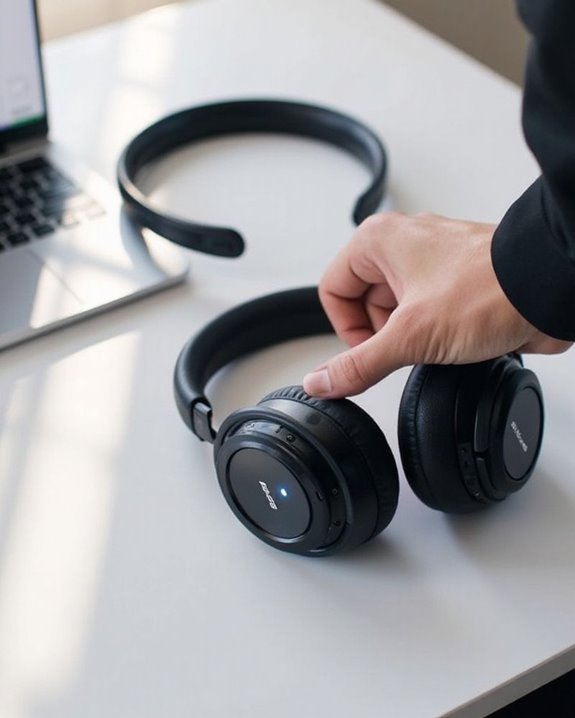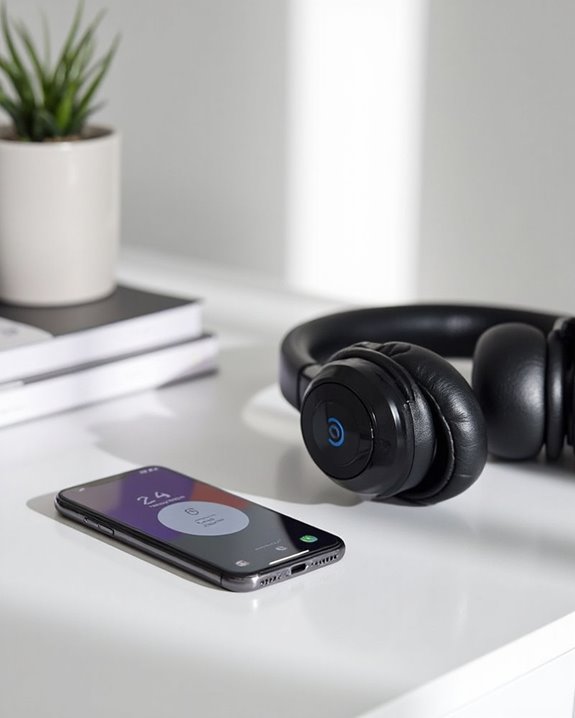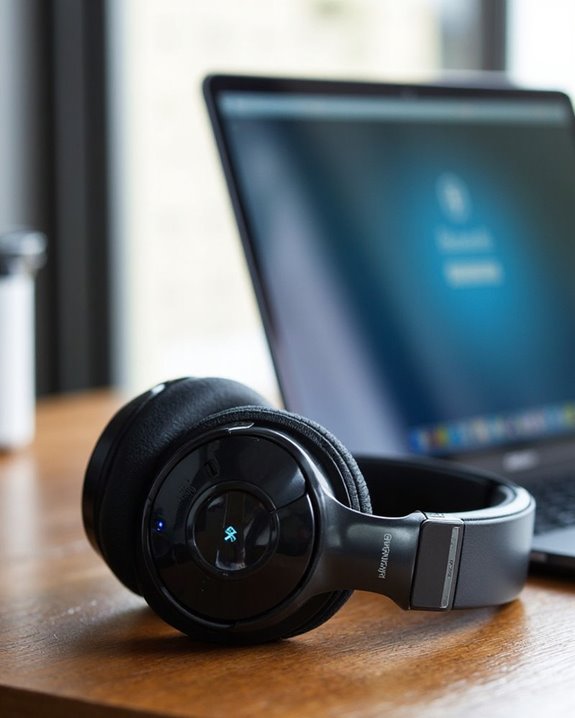Driving with headphones is illegal in 15 states, including California, Maryland, and New York, while 35 states permit their use without restrictions. States with bans typically prohibit covering both ears but may allow single-ear use. Penalties range from $25-$200 fines, with potential license points in some jurisdictions. Active noise-cancellation headphones pose greater safety risks by blocking critical sounds like sirens and horns. Additional state-specific exemptions and regulations reveal important nuances for interstate travelers.
Key Takeaways
- Legality varies by state with 35 states allowing headphone use while driving without restrictions.
- California, Louisiana, Maryland, Minnesota, Virginia, Washington, and Alaska completely ban driving with headphones.
- Some states permit single-ear headphone use while banning dual-ear coverage for safety reasons.
- Wearing headphones while driving increases reaction times and reduces awareness of emergency sirens and horns.
- Fines for driving with headphones range from $25-$350 depending on the state, with potential license points in some jurisdictions.
State-by-State Headphone Laws While Driving
When it comes to wearing headphones while driving, the legal landscape across the United States varies dramatically from state to state. Currently, 35 states permit driving with headphones without specific restrictions, while others maintain explicit bans or limitations.
States like Maryland and Delaware prohibit covering both ears while driving, reflecting regional safety priorities that have developed alongside cultural influences in transportation norms. Some jurisdictions allow single-ear headphone use, balancing connectivity needs with safety concerns.
Economic factors also play a role in enforcement patterns, as fines and penalties differ greatly between states. Urban areas often implement stricter enforcement due to higher traffic density and accident rates.
Law enforcement personnel and hearing aid users frequently receive exemptions from these regulations. Drivers should research their specific state laws, as penalties may include fines and license points.
Using helmet headphones with features like noise cancellation technology can enhance rider safety by ensuring clear audio without blocking important ambient sounds.
The Safety Risks of Wearing Headphones Behind the Wheel
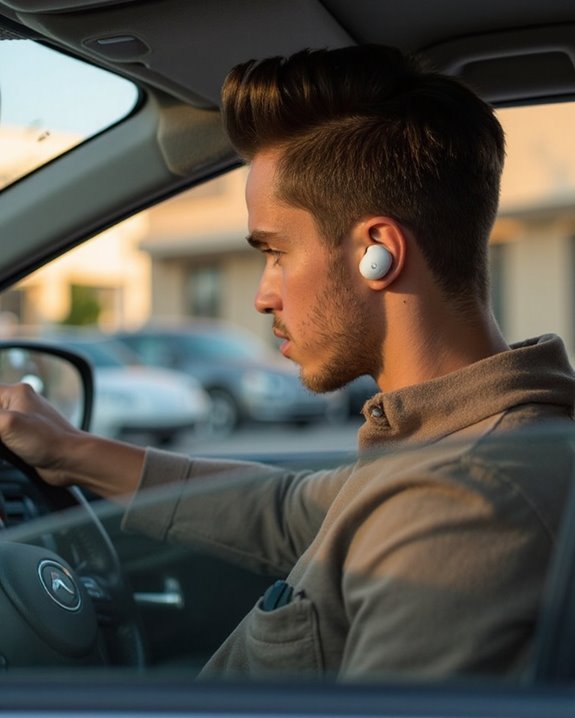
Beyond the legal variations across states, understanding the concrete safety implications of wearing headphones while driving reveals why many jurisdictions restrict this practice. Research demonstrates that headphones substantially increase Reaction Delay times when responding to hazards, particularly emergency vehicles.
Studies confirm that drivers experience Cognitive Overload when processing audio through headphones while simultaneously managing driving tasks. This divided attention impairs vital roadcraft skills, resulting in more steering errors and decreased situational awareness.
The safety data is concerning: headphones prevent drivers from hearing critical auditory cues like sirens or horns and can impair judgment of speed and distance. The resulting effects—reduced hazard perception, compromised decision-making abilities, and longer stopping distances—create a measurably higher accident risk compared to driving without audio distractions.
Notably, noise cancelling headphones excel at blocking low-frequency sounds, which include many important vehicle and emergency signals, further exacerbating the safety risks when worn behind the wheel.
How Headphones Affect Your Driving Awareness
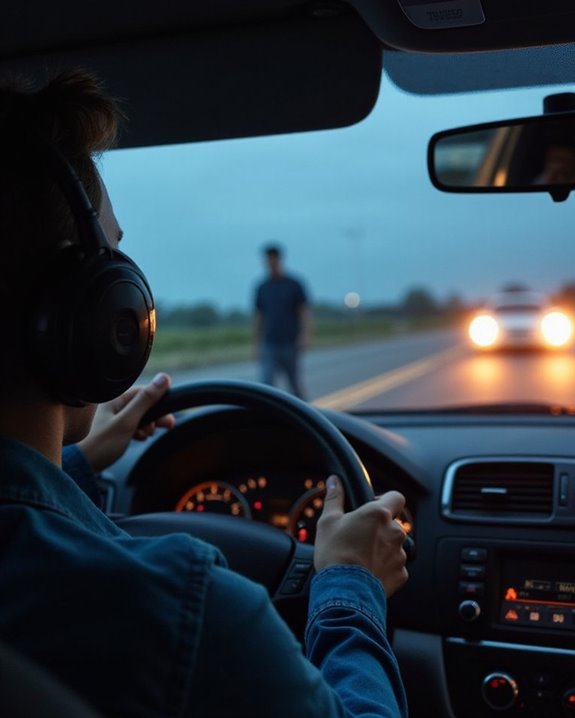
How greatly can a simple pair of headphones compromise a driver’s safety on the road? The Audio Impact of headphones substantially reduces a driver’s ability to detect critical external sounds like sirens, horns, and engine noises that serve as vital warning signals.
Headphones create a serious Cognitive Shift by dividing attention between driving tasks and audio content. This division leads to measurably slower reaction times—often 0.2-0.3 seconds longer—which translates to several additional meters before braking in emergency situations.
Furthermore, spatial awareness becomes distorted, making it difficult to accurately locate the direction of approaching vehicles or emergency signals. This auditory isolation is particularly dangerous in complex traffic environments where drivers need heightened vigilance and complete situational awareness to navigate safely.
Even advanced headphones with active noise cancellation can exacerbate these risks by further blocking out essential environmental sounds.
Legal Consequences for Driving With Headphones

The legal landscape regarding headphone use while driving varies dramatically across the United States, creating a patchwork of regulations drivers must navigate carefully. In states with explicit bans like California, Maryland, and Virginia, violations typically result in fines ranging from $50-$200 and potential license points.
These Record Impacts can be significant, as accumulated points may lead to license suspension and substantially higher insurance premiums. Most jurisdictions treat headphone infractions as moving violations, which remain on driving records for 3-5 years.
Drivers do have Appeal Options if cited, typically through traffic court proceedings where they can contest charges based on medical necessity or technical specifications of their devices. However, successful appeals generally require documented evidence and often professional legal assistance.
Exceptions to Headphone Driving Laws
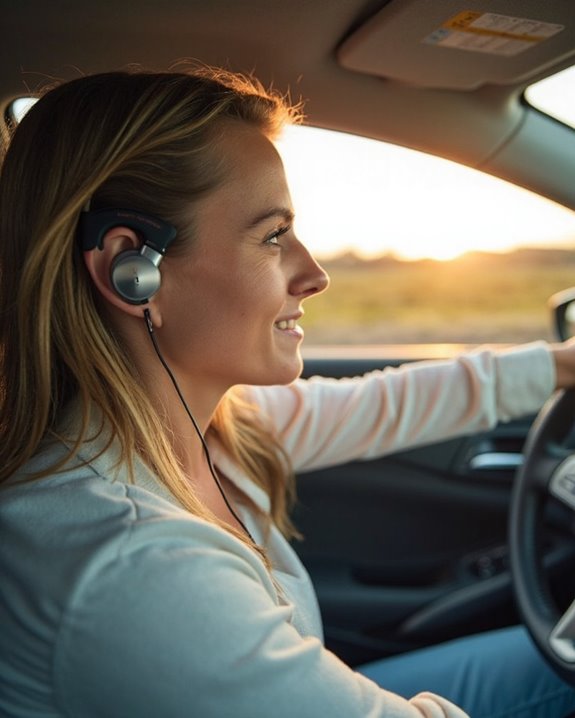
While most jurisdictions restrict headphone use while driving, several important exceptions exist that drivers should understand. These Device Exemptions typically include single-ear headsets and hands-free communication devices, which allow drivers to maintain awareness of traffic sounds while using technology safely.
Operator Exceptions apply to specific professionals, particularly emergency vehicle drivers who may have special allowances for communication equipment necessary for their duties. Additionally, hearing aids and assistive listening devices are generally permitted, as they’re considered medical necessities rather than entertainment devices.
Geographic variations also exist, with some states permitting single-ear use while others maintain stricter regulations. Drivers should always research local laws before traveling across state lines to guarantee compliance with region-specific headphone regulations.
Alternatives to Wearing Headphones While Driving
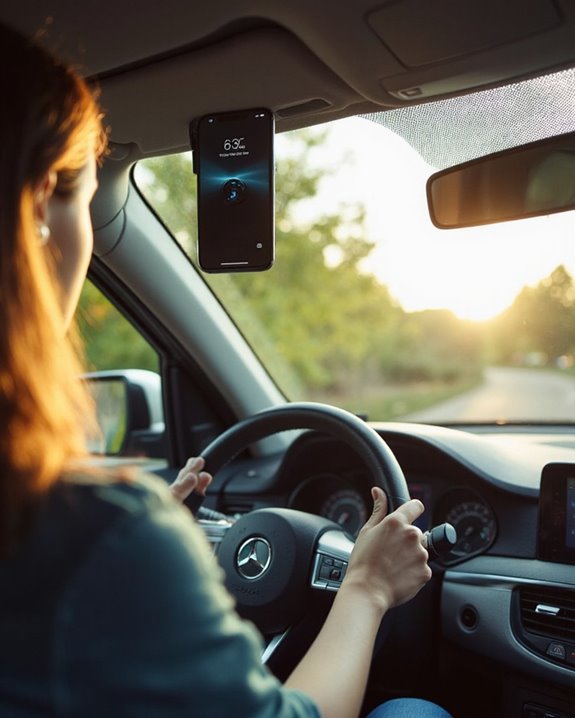
Several viable alternatives exist for drivers seeking entertainment or communication options without resorting to potentially illegal headphone use. Modern car audio systems provide high-quality sound while allowing drivers to remain aware of important external noises such as emergency sirens and horns.
Bluetooth connectivity offers hands-free communication through vehicle speakers or single-ear headsets, maintaining compliance with legal requirements in most jurisdictions. These solutions support music streaming and phone calls without compromising safety.
Voice integration technology, including assistants like Siri and Google Assistant, enables drivers to control entertainment, navigation, and messaging through simple verbal commands. This reduces the need for manual interaction with devices while driving.
For vehicles lacking built-in technology, aftermarket solutions such as phone mounts and Bluetooth adapters provide safe access to entertainment without headphones.
How Law Enforcement Detects Headphone Use
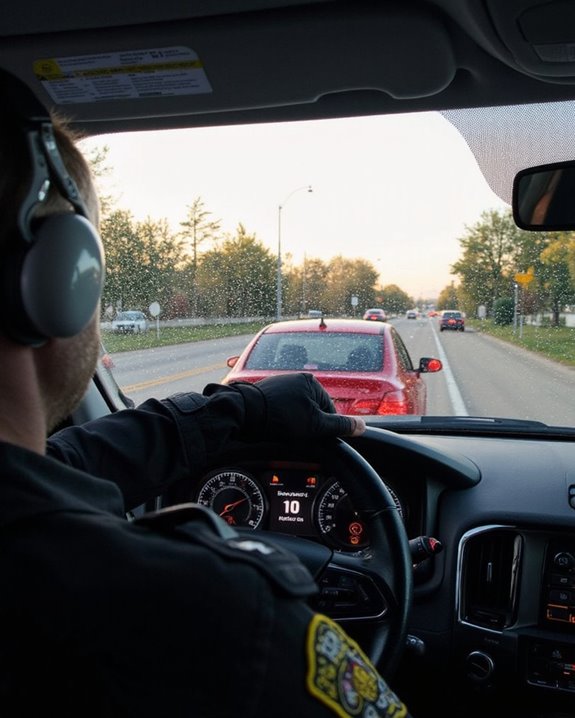
Law enforcement officers employ various methods to detect drivers wearing headphones on the road, ranging from simple visual observation to more sophisticated technological approaches. They watch for behavioral cues such as drivers adjusting earbuds, unusual head movements, or delayed responses to environmental sounds.
Officers may utilize emerging sensor technology that detects handheld versus hands-free device usage. Some systems employ ultrasonic pulses to identify headphone-connected phone use, while others monitor Bluetooth signals under specific circumstances.
Detection often relies on indirect evidence, including:
- Audible music suggesting headphone use
- Impaired response to verbal commands
- Distracted driving patterns
- Witness reports or dashcam footage
These methods face significant challenges, particularly with small wireless earbuds and the difficulty distinguishing between legal hands-free devices and prohibited headphones—often requiring additional verification during traffic stops.
Regional Differences in Headphone Driving Legislation
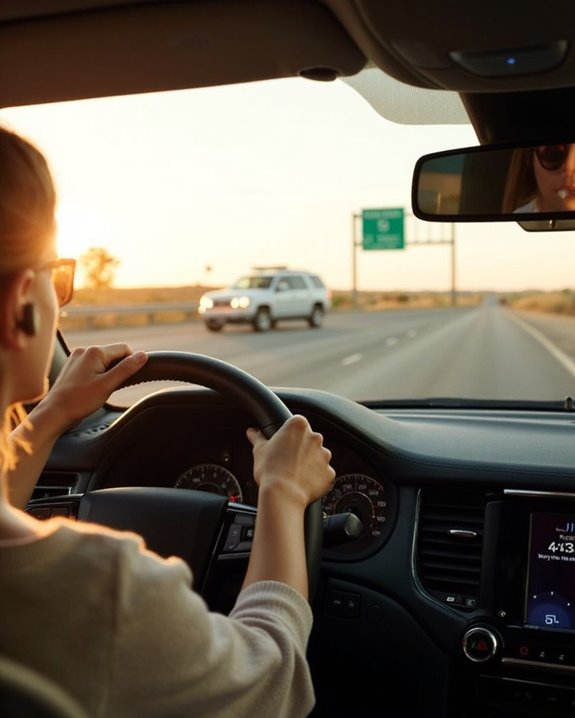
Despite sharing roadways across the United States, drivers face a patchwork of regulations regarding headphone use behind the wheel. The West Coast maintains stricter prohibitions, with California and Washington explicitly banning dual-ear headphone use, while many central and southern states adopt more permissive approaches.
Cultural influences have shaped these regional variations, with northeastern states typically relying on broader distracted driving statutes rather than specific headphone legislation. States experiencing significant demographic shifts, particularly those with growing urban populations, have begun reconsidering their stance on audio device restrictions.
Penalty severity reflects regional priorities: Ohio treats violations as escalating misdemeanors with fines up to $150, while Louisiana imposes just $25 fines. This legislative inconsistency creates challenges for interstate travelers, who must adapt to different standards when crossing state lines.
The Evolution of Headphone Driving Laws Through 2025

The shifting landscape of headphone driving legislation continues to evolve as technology advances and safety concerns mount. Law Origins trace back to early restrictions focused on auditory isolation risks, with states like California and Maryland pioneering prohibitions against headphone use while driving.
By 2025, six states—California, Louisiana, Maryland, Minnesota, Virginia, and Washington—have implemented complete bans, with Washington specifically updating its legislation in 2022 to include wireless earbuds. Michigan’s 2023 proposal signals ongoing Trend Forecasts toward stricter regulations nationwide.
This legislative progression reflects mounting scientific evidence of safety risks, including studies showing Active Noise Cancellation technology can reduce external sound awareness by up to 30dB. Enforcement mechanisms have similarly evolved, with first-offense penalties typically ranging from $50 to $350.
What Drivers Need to Know About Headphone Regulations

Handling headphone regulations while driving presents a complex challenge for motorists across the United States due to major variations in state laws. Drivers must recognize that what’s permissible in one jurisdiction may be illegal in another, with penalties ranging from fines to potential Insurance impacts if violations contribute to accidents.
States including California, Alaska, and Maryland maintain complete bans, while others permit single-ear use or specific exceptions for GPS navigation and communication devices. Professional drivers often face stricter standards regarding headphone use.
Beyond domestic considerations, travelers should note that Global regulations differ greatly—many European countries prohibit headphone use while driving entirely. Drivers can protect themselves legally by:
- Researching local laws before travel
- Using vehicle sound systems instead of headphones
- Utilizing built-in Bluetooth when available
Frequently Asked Questions
Can I Wear One Earbud While Driving Instead of Two?
Wearing a single earbud while driving is allowed in several states, balancing communication needs with driver awareness. Earbud safety considerations emphasize maintaining environmental awareness, while minimizing driving distractions that could compromise road safety.
How Do Headphone Laws Apply to Motorcycle or Bicycle Riders?
Motorcycle and bicycle riders face specific regulations for headphone use. Many states permit single-earbud use or helmet-integrated systems while prohibiting dual headphones. Cycling safety guidelines emphasize minimizing rider distractions to maintain situational awareness.
Do Headphone Laws Differ for Rideshare or Commercial Drivers?
Picture a driver maneuvering through regulations. While standard headphone laws apply to all, Commercial Variations impose stricter federal oversight on CDL holders, yet Rideshare Exemptions are virtually non-existent with companies often enforcing their own policies.
Can I Use Bone Conduction Headphones Legally While Driving?
Bone conduction headphones may be legal in many states due to their design benefits. They don’t block ear canals, providing conduction safety advantages by allowing drivers to maintain awareness of surrounding sounds and traffic conditions.
Are There Specific Laws for Driving With Noise-Cancelling Headphones?
No specific laws target noise-cancelling headphones distinctly. They fall under general headphone restrictions in many states. Headphone safety concerns focus on reduced awareness, while legal penalties typically involve fines regardless of headphone type.


